Four years later the Winter Olympics were held for a second time and Canada would complete a hat trick of golds, and with that, their third consecutive World Championship, as the Olympic hockey tournament was also considered that year's World Championship up until 1972, when a separate World Championship was held in the same year as the Winter Olympics for the first time.
Canada won the first formal World Championships which were not a part of the Winter Olympics in 1930 and again in 1931. Their fifth World Championship came at the 1932 Winter Olympics in Lake Placid, New York.
In 1933, the United States ended Canada's streak at six with a 2-1 overtime win in the gold medal game, but the Canadians returned to their winning ways in 1934 and 1935. Great Britain shocked the hockey world with a gold at the 1936 Winter Olympics before Canada would win the final three World Championships (1937-1939) before World War II would put the World Championships on hold until 1947, which was won by Czechoslovakia.
Canada would win titles at the 1948 Olympics, 1950, 1951 and the 1952 Olympics before Sweden broke through with their first title in 1953.
The world of hockey changed forever in 1954 with the arrival of the Soviet Union, who defeated the dominant Canadians 7-2 in the final contest.
While the Canadians now had some very real competition, they were not down and out my any means, as they rebounded with a first place in 1955, but the Soviets took home their first Olympic gold in 1956. After Sweden won their second in 1957 (with the United States and Canada not attending the tournament in Moscow in protest of the Soviet occupation of Hungary), Canada would win again in 1958 and 1959, only to see the United States win the 1960 Olympics on home ice in Squaw Valley.
The World Championship that Canada would win in 1961 was their 19th (out of a possible 28) since 1920. At the time, only the United States (2), Sweden (2), the Soviet Union (2), Czechoslovakia (2) and Great Britain (1) and dared beat the Canadians at their own game.
Up until this point, the winners of the Allan Cup, as Canada's senior hockey national champions, would represent Canada at the World Championships and Olympic Games, but beginning in 1962, Canada would implement a new national team program to bring together not just the best club in the land, but now with a focus on the best players from Canada, although these were still amateurs - a key distinction in the face of Soviet and Czech dominance.
After Sweden captured their third title in 1962, the World Championships became the exclusive playground of the communists, and the Soviet Union in particular. The Soviets reeled off nine straight titles from 1963 through 1971, which included the final two Winter Olympics which counted as the World Championship in 1964 and 1968. Their streak was needed by Czechoslovakia in 1972, the first time the World Championships was held as it's own stand alone tournament during an Olympic year.
While the Canadian players were strictly amateurs, the players used by the Communist countries were amateur in name only, as they were paid to be soldiers in the Army, but their assigned military duties were to play hockey, thus maintaining their "amateur" status, which frustrated and angered the Canadians in particular.
Canada appealed to be able to use professional players, which was approved by the IIHF to a limited degree in 1969, declaring that the Canadians could use up to nine non-NHL professionals as a one year experiment at the 1970 World Championships, which were to be hosted in Canada for the first time. However, the International Olympic Committee president Avery Brundage was opposed to the idea of amateurs and professionals competing against each other, and declared hockey's status as an Olympic sport would be in jeopardy if the plan went forward in January of 1970. In the end, the IIHF reversed it's decision and Canada was again told they could not use any professionals.
The Canadians reacted swiftly and decisively, declining to host the 1970 World Championships as well as completely withdrawing from international competition effective immediately until the World Championship was made an "open competition", which would accept all players on an even playing field, which they felt was no longer the case.
Their withdrawal lasted for eight years, causing them to miss seven World Championships as well as the 1972 and 1976 Olympics. During Canada's absence, the Czechs won the World Championship in 1972 and 1976, with the Soviets on top in 1970, 1971 and 1973 through 1975 as well as both the 1972 and 1976 Olympics.
Finally an agreement was reach which returned Canada to the world of international hockey in 1977 when Günter Sabetzki became the president of the IIHF in 1975 and made the World Championships an open competition, as well as moving them to later in the season, which allowed players not involved in the NHL playoffs a chance to participate. The Olympics were a different story, as they remained an amateur only event, which was still held during the stretch drive of the NHL season.
The effect was immediate, as Canada fielded a team which included none other than two-time NHL MVP Phil Esposito! Canada suffered some growing pains, as the current generation of players was not used to the international game and it's larger ice surface, but still managed a respectable fourth place finish. With the fear that the younger players were losing their place in the World Championships, the IIHF promoted the Under-20 championships to full World Championship status that same year, giving rise to the now immensely popular "World Juniors".
Still, with Canada lacking it's best NHL professionals in the face of the veteran talent from the Soviet Union, the "Big Red Machine" rolled on, winning titles from 1978 to 1983, but the Canadians kept trying, with their efforts rewarded with bronze medals in 1978, 1982, 1983, 1986, and silver medals in 1985, 1989 and 1991 thanks in part to the efforts of the "Program of Excellence", which began in 1983 to put together a national team which would play a full season as a unit in games all over the world, often a combination of top NHL prospects, veteran pros as well as players seeking a team while in a contract dispute with their NHL club on occasion.
Elsewhere in the world, the Soviet Union broke apart in late 1991, throwing their once dominant program into a period of disarray as the Russians sought to reorganize their national team program. Sweden meanwhile, was at a peak with their program, winning gold in 1987, 1991 and 1992, and silver in 1990 and 1993, a tournament won for the first time by Russia, who were again a force to be reckoned with, but not the steamroller they once were.
The world reconvened for the 1994 World Championships in Italy for the first time since 1956, with the 12 participating teams being divided into two groups of six. On April 25th Canada opened the tournament with a 4-1 win over the host Italians with goals by Joe Sakic, Geoff Sanderson, Yves Racine and Mike Ricci. They then hammered Austria 6-1, with Sanderson, Nelson Emerson, Rod Brind'Amour and a hat trick by Paul Kariya (who led Canada with 5 goals and 12 points) accounting for the goals by Canada.
Germany was downed 3-2 with Brendan Shanahan being the hero of the day, scoring all three goals for Canada. Great Britain was dominated 8-2 with goals from Ricci, Emerson, Shayne Corson (twice), Sakic, Pat Verbeek, Stephen Thomas, and Brind'Amour, setting up a final game with Russia, who were also undefeated.
After falling behind 1-0, Canada roared back with three third period goals by Sanderson and Sakic before Sakic sealed the victory with an empty net goal with just two seconds remaining to secure the top seed in Group 1 and a date with the fourth place finisher, the Czech Republic (1-2-2) in the Quarterfinals.
The Czech's poor record in the First Round proved deceptive, as they broke out on top with a goal at 4:12. Shanahan tied it for Canada at 12:20 and Kariya put Canada ahead at 5:58 of the second, only to have the Czechs tie it 1:40 later. The game then remained scoreless until Corson broke the tie with 2 1/2 minutes remaining to give Canada a 3-2 win.
Their Semifinal opponent was Sweden, second in Group 2 at 3-1-1, but they offered little resistance to an on-form group of Canadians, who blitzed the Swedes 6-0, with goals coming from Luc Robitaille, who had a hat trick, Sanderson, Kariya and Brind'Amour, setting up a championship final with Finland, who had won Group 2 with four wins an a tie.
The game, played on this date in 1994, saw the teams play the first two periods scoreless before trading goals in the third period, with Brind'Amour scoring with 4:43 left on a power play to tie the score at 1-1 at the end of regulation, as Bill Ranford and Jarmo Myllys stood tall in the nets. Overtime passed without a winner as Canada out shot Finland 5-3, moving the game onto penalty shots.
Robitaille put Canada up 1-0 after the first round and Sakic gave Canada a commanding 2-0 lead after the second. Neither team scored in the third round, but the tide quickly turned as Finland scored in rounds 4 and 5, while Kariya and Verbeek were stopped by Myllys, sending the shootout into extra rounds tied at 2-2. Robitaille, able to shoot again under international rules, converted on his second opportunity after momentarily losing control of the puck, but regained it in time to brilliantly deke Myllys and find the back of the net to give Canada the lead. Randford then stopped Mika Nieminen to secure the first gold medal for Canada in 33 years of waiting, dating back to 1961, when they were represented by the Trail Smoke Eaters in an era long since past.
Canada would repeat as champions in 1997, 2003 and 2004 and again in 2007, their 24th World Championship. Additionally, with the inclusion of the NHL professionals in the Olympics beginning in 1998, Canada has also won Olympic gold in both 2002 and 2010, their first since 1952 when they were represented by the Edmonton Mercurys.
Today's featured jersey is a 1994 Canada National Team Joe Sakic jersey as worn during the 1994 World Championships during which Canada ended their 33 year World Championship drought. The jersey is a Finnish made jersey produced by Tackla of Finland, but branded as a Reebok jersey, using the dye sublimation process, in which all the graphics are created by injecting ink into the fabric, which is then cured with heat. This jersey also sports a pair of Warsteiner Beer sponsorship logos, giving the jersey it's unique "World Championships" look, as jerseys worn during the Olympics are free from advertising.
This multi-striped style was a short-lived one and only used for the 1994 and 1995 World Championships, as Nike arrived on the scene with all new designs for the 1996 World Championships.
Bonus jersey: Today's bonus jersey is a 1977 Canada National Team Phil Esposito jersey. This brash style loudly announced Canada's return to international competition when it was worn at the 1977 World Championships after Canada withdrew from international hockey for eight years in protest of eligibility rules of professional players versus the veteran Soviet players who were able to maintain their amateur status.
Somewhat surprisingly, this style continued to be worn through 1979 and is perhaps the only jersey Canada has ever worn that could not be described as classy or at least attractive, with the exception of the first mustard colored sweaters from 1920, which were revived as an ill-advised throwback in 2004.

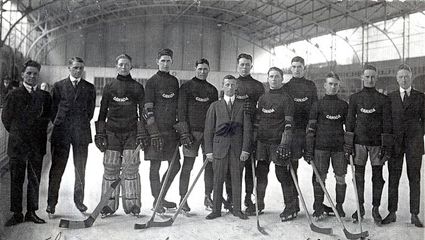
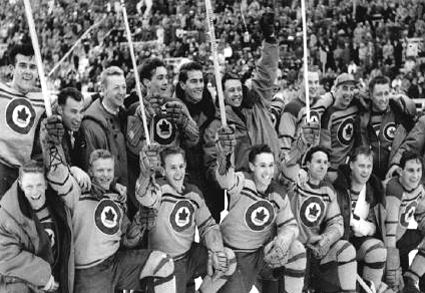


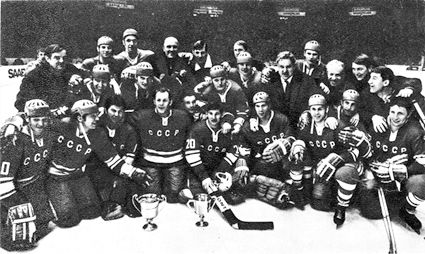
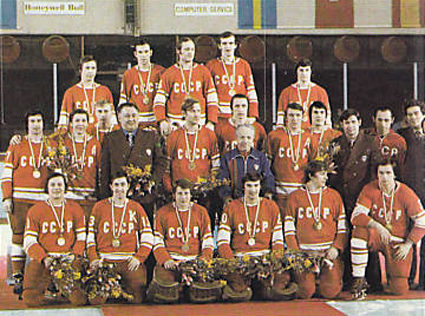

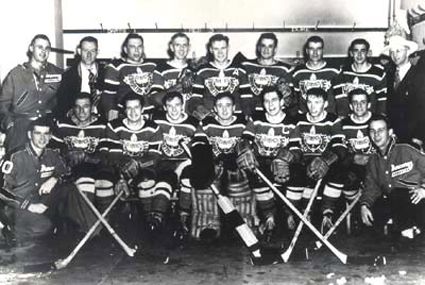
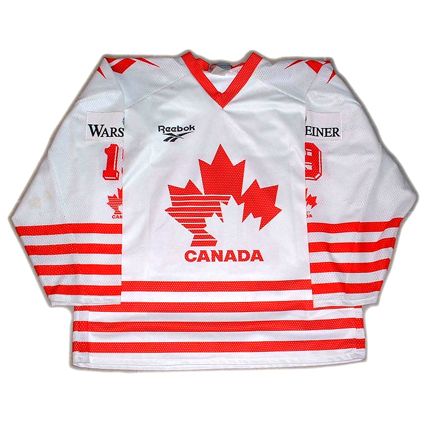
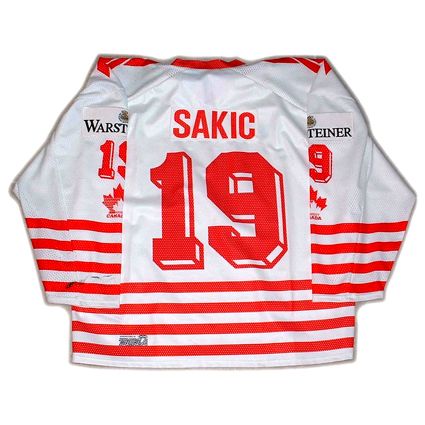
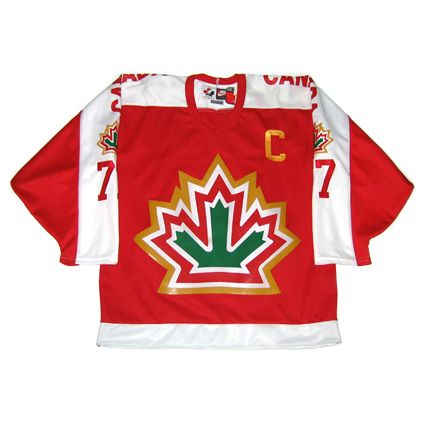
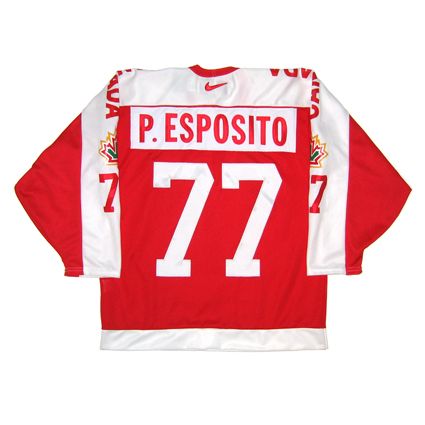










No comments:
Post a Comment
We welcome and encourage genuine comments and corrections from our readers. Please no spam. It will not be approved and never seen.